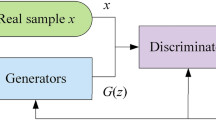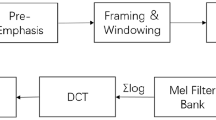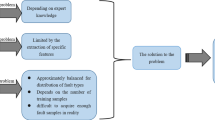Abstract
The healthy and stable operation of the ship’s power system is the foundation for the normal navigation of a ship. Data-driven ship power system condition monitoring is currently one of the research directions, but such methods often require a large amount of labeled data support. How to obtain a sufficient number of fault samples is the first problem to be solved for such methods. Therefore, a new fault sample generation scheme is proposed, which first uses the finite element method (FEM) to generate vibration data of marine diesel engines in different fault states, and uses deep convolutional generative adversarial network (DCGAN) to narrow the domain difference between simulation data and measured data, while retaining the fault characteristics of the simulation data, thereby generating synthetic fault data that is closer to the real fault state. The iteration number is determined through the comparison of time-domain, frequency-domain, loss function changes, and fault type identification results of synthetic data, measured data, and simulation data. The quality of the synthetic data is judged, and ultimately, a high-quality data sample for model training is generated.
Similar content being viewed by others
References
X. Xu, X. Yan, K. Yang, J. Zhao, C. Sheng and C. Yuan, Review of condition monitoring and fault diagnosis for marine power systems, Transportation Safety and Environment, 3(2) (2021) 85–102, https://doi.org/10.1177/14750902221149.
M. Orhan and M. Celik, A literature review and future research agenda on fault detection and diagnosis studies in marine machinery systems, Proceedings of the Institution of Mechanical Engineers, Part M: J. of Engineering for the Maritime Environment (2023) https://doi.org/10.1177/14750902221149291.
P. Han, A. L. Ellefsen and G. Li, Fault prognostics using LSTM networks: application to marine diesel engine, IEEE Sensors J., 21(22) (2021) 25986–25994.
C. Li, C. Chen and X. Gu, Acoustic signal analysis for gear fault diagnosis using a uniform circular microphone array, J. of Mech. Sci. and Tech., 37 (2023) 5583–5596.
S. Aslam, M. P. Michaelides and H. Herodotou, Internet of ships: A survey on architectures, emerging applications, and challenges, IEEE Internet of Things J., 7(10) (2020) 9714–9727, DOI: https://doi.org/10.1109/JIOT.2020.2993411.
G. Yan, Y. Hu and J. Jiang, A novel fault diagnosis method for marine blower with vibration signals, Polish Maritime Research, 29(2) (2022) 77–86, https://doi.org/10.2478/pomr-2022-0019.
D. Zhang, T. Hou, J. Yang and J. Xiao, Study on marine diesel engine fault identification based on neural network, 2022 IEEE International Conference on Mechatronics and Automation (ICMA), Guilin, China (2022) DOI: https://doi.org/10.1109/ICMA54519.2022.9856137.
S. M. Ramteke, H. Chelladurai and M. Amarnath, Diagnosis and classification of diesel engine components faults using time-frequency and machine learning approach, J. of Vibration Engineering & Technologies, 10(1) (2022) 175–192.
Y. Liu, J. M. Zhang, Y. T. Min, Y. Yu, C. Lin and Z. Z. Hu, A digital twin-based framework for simulation and monitoring analysis of floating wind turbine structures, Ocean Engineering, 283 (2023) 115009, https://doi.org/10.1016/j.oceaneng.2023.115009.
Y. Gao, X. Liu and J. Xiang, FEM simulation-based generative adversarial networks to detect bearing faults, IEEE Transactions on Industrial Informatics, 16(7) (2020) 4961–4971.
D. Zhang, P. Tong, W. Zhu and J. Zheng, Research on reciprocating diesel engines fault diagnosis based on adaptive genetic algorithm optimization, 2022 IEEE 6th Advanced Information Technology, Electronic and Automation Control Conference (IAEAC), Beijing, China (2022).
J. Liao, H. Yu, J. Yan and S. H. Hsu, Simulation and modal analysis of marine diesel engine based on finite element model and vibration sensor data, Sensors & Materials, 33(5) (2021) 1645–1656.
Z. Gao, B. Huo, J. Zhang and Z. Jiang, Failure investigation of gear teeth fracture of seawater pump in a diesel engine, Engineering Failure Analysis, 105 (2019) 1079–1092.
I. Goodfellow, J. Pouget-Abadie, M. Mirza, B. Xu, D. Warde-Farley and S. Ozair, Generative adversarial nets, Advances in Neural Information Processing Systems, 27 (2014).
Z. Wang, J. Wang and Y. Wang, An intelligent diagnosis scheme based on generative adversarial learning deep neural networks and its application to planetary gearbox fault pattern recognition, Neurocomputing, 310 (2018) 213–222.
D. Zhao, F. Liu and H. Meng, Bearing fault diagnosis based on the switchable normalization SSGAN with 1-D representation of vibration signals as input, Sensors, 19(9) (2019) 2000.
P. Han, A. L. Ellefsen, G. Li, F. T. Holmeset and H. Zhang, Fault detection with LSTM-based variational autoencoder for maritime components, IEEE Sensors J., 21(19) (2021) 21903–21912, DOI: https://doi.org/10.1109/JSEN.2021.3105226.
G. R. Djavanshir, X. Chen and W. Yang, A review of artificial intelligence’s neural networks (deep learning) applications in medical diagnosis and prediction, It Professional, 23(3) (2021) 58–62, DOI: https://doi.org/10.1109/MITP.2021.3073665.
S. Liu, M. Yu, M. Li and Q. Xu, The research of virtual face based on deep convolutional generative adversarial networks using TensorFlow, Physica A: Statistical Mechanics and its applications, 521 (2019) 667–680, https://doi.org/10.1016/j.physa.2019.01.036.
S. Shao, P. Wang and R. Yan, Generative adversarial networks for data augmentation in machine fault diagnosis, Computers in Industry, 106 (2019) 85–93.
Y. Gao, X. Liu, H. Huang and J. Xiang, A hybrid of FEM simulations and generative adversarial networks to classify faults in rotor-bearing systems, ISA Transactions, 108 (2021) 356–366, https://doi.org/10.1016/j.isatra.2020.08.012.
T. Han, C. Liu, W. Yang and D. Jiang, A novel adversarial learning framework in deep convolutional neural network for intelligent diagnosis of mechanical faults, Knowledge-based Systems, 165 (2019) 474–487, https://doi.org/10.1016/j.knosys.2018.12.019.
Y. O. Lee, J. Jo and J. Hwang, Application of deep neural network and generative adversarial network to industrial maintenance: A case study of induction motor fault detection, 2017 IEEE International Conference on Big Data (big data), Boston, MA, USA (2017) 3248–3253.
L. J. Ratliff, S. A. Burden and S. S. Sastry, Characterization and computation of local Nash equilibria in continuous games, 2013 51st Annual Allerton Conference on Communication, Control, and Computing (Allerton), Monticello, IL, USA (2013) DOI: https://doi.org/10.1109/Allerton.2013.6736623.
A. Radford, L. Metz and S. Chintala, Unsupervised representation learning with deep convolutional generative adversarial networks, arXiv:1511.06434 (2015) https://doi.org/10.48550/arXiv.1511.06434.
J. Viola, Y. Chen and J. Wang, FaultFace: deep convolutional generative adversarial network (DCGAN) based ball-bearing failure detection method, Information Sciences, 542 (2021) 195–211, https://doi.org/10.1016/j.ins.2020.06.060.
E. A. Sim, S. Lee, J. Oh and J. Lee, GANs and DCGANs for generation of topology optimization validation curve through clustering analysis, Advances in Engineering Software, 152 (2021) 102957, https://doi.org/10.1016/j.advengsoft.2020.102957.
Y. He, H. Tang, Y. Ren and A. Kumar, A semi-supervised fault diagnosis method for axial piston pump bearings based on DCGAN, Measurement Science and Technology, 32(12) (2021) 125104, DOI: https://doi.org/10.1088/1361-6501/ac1fbe.
Y. Li and K. Wang, An automatic FIR and DCGAN modelbased fault detection framework for key components of planetary gearboxes under compartively stable conditions, 2019 Prognostics and System Health Management Conference (PHM-Qingdao), Qingdao, China (2019).
Acknowledgments
This work was supported by the National Natural Science Foundation of China (Grant No. 52271328). The authors are grateful to the editors and anonymous reviewers for their helpful comments and constructive suggestions.
Author information
Authors and Affiliations
Corresponding author
Additional information
Baoyue Li is a doctoral student of Marine Engineering at Wuhan University of Technology. His main research interests are fault diagnosis and remaining life prediction of mechanical equipment.
Yonghua Yu is a Professor and Ph.D. supervisor in the School of Marine and Energy Power Engineering at Wuhan University of Technology. He received his Ph.D. in Marine Engineering from Wuhan University of Technology. His research interests include ship power system health management and intelligence, ship power system vibration and noise control technology
Rights and permissions
About this article
Cite this article
Li, B., Yu, Y., Wang, W. et al. Sample generation method for marine diesel engines based on FEM simulation and DCGAN. J Mech Sci Technol 38, 2335–2345 (2024). https://doi.org/10.1007/s12206-024-0414-4
Received:
Revised:
Accepted:
Published:
Issue Date:
DOI: https://doi.org/10.1007/s12206-024-0414-4




